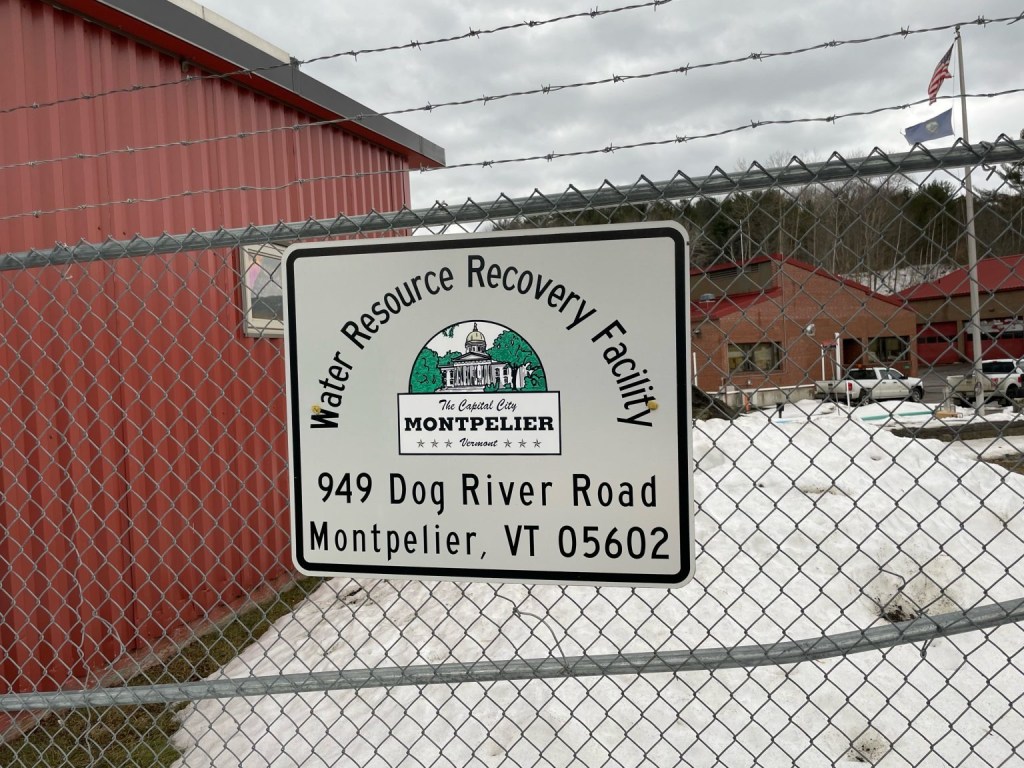

This story by John Dillon was first published in The Bridge on Nov. 7.
The city of Montpelier has shelved an ambitious but expensive plan to upgrade its wastewater treatment plant with technology that would remove hazardous “forever” chemicals from its sewage sludge.
Faced with cost estimates that jumped from $16.4 million to $32.4 million, the city council on Oct. 23 opted to proceed with just the preliminary phase of the project. This option allows the public works department to install equipment to dry the sludge, reduce odors at the plant, and to make other improvements. But councilors delayed the plan for more advanced equipment that would superheat the waste to virtually eliminate levels of per- and polyfluoroalkyl substances (PFAS).
The option chosen by the council will cost about $21 million. Mayor Jack McCullough noted that the city could install the more expensive technology at a later date. But with another bond vote needed to pay for the escalating cost — and the city’s budget already under strain — delaying the project “all adds up to almost a no brainer,” McCullough said.
The decision means the city still has a PFAS problem. Its sewage treatment plant is the only one in the state that accepts PFAS-contaminated leachate from the Casella landfill in Coventry.
Public Works Director Kurt Motyka said an experimental pre-treatment system installed in Coventry has reduced the levels of five different PFAS compounds in the leachate by 89% to 94%. Yet because the chemicals are pervasive in a range of consumer products, some PFAS still ends up in sewage sludge, even without the Casella leachate.
Currently, the city ships its sludge to the Coventry landfill but pays a reduced rate because it also accepts Casella’s leachate. Motyka told the city council that without the more advanced treatment the city’s options for disposing of the sludge remain limited.
The PFAS group of chemicals was used in a range of consumer products from cosmetics, to carpets, to Teflon non-stick cookware. State and federal regulators have moved in recent years to restrict the use of PFAS as new evidence emerges that they are virtually everywhere in the environment.
Indeed, a 2019 study done for the state of Vermont found minute levels of PFAS in every soil sample tested from 66 sites around the state. Researchers believe these background levels are likely due to atmospheric deposition as chemicals released by industry are carried long distances by the wind.
The compounds are known as “forever chemicals” because they break down very slowly in the environment. They are linked to a number of health concerns, including cancer, low birth weights, high cholesterol and damage to the immune system.
“This stuff is so ubiquitous,” says John Brabant, a former environmental regulator with the Agency of Natural Resources who now works with the advocacy group Vermonters for a Clean Environment.
Sewage sludge has been a major source of PFAS contamination. The sludge — known in the waste industry as “biosolids” — was routinely applied to farm fields as fertilizer. The state of Maine has banned land application of sewage sludge after fields and farms were contaminated. Vermont still allows land application of sludge but has strictly limited its practice. Massachusetts and New Hampshire are also considering banning land application of sludge.
Since 2019, the Vermont Department of Environmental Conservation has required testing of the soils where sludge has been applied as well as the groundwater near the sites. The state found PFAS levels exceeding state standards in 31 of 138, or 23%, of the groundwater monitoring wells. But officials say that to date no drinking water supplies have been affected by PFAS from sludge applied to land.
Montpelier’s sludge is not spread on farm fields. Public Works Director Motyka said the first phase of the project to dry the sludge would cut disposal costs because the volume of the material would be reduced. Drying the sludge could also give the city other options, such as spreading the sludge on land, he said.
“By doing just the dryer without doing the secondary advanced thermal treatment — that’s the component that breaks down the PFAS — we would have the potential to land apply (the sludge). But we would still have to go through the permitting process for that,” Motyka told the council.
Whether the city would get approval to spread the sludge without the system that breaks down the PFAS is another question. The state has drafted rules that would limit land application to sites where the sludge being applied does not exceed background levels in the soil.
“Pretty much all our sludge is going to have PFAS,” said Eamon Twohig, manager of the Vermont’s Residuals and Emerging Contaminants Program. “The goal is to basically keep Vermont soil levels at those — quote unquote — ‘background’ levels and not to increase those levels.”
The advanced thermal treatment breaks apart the carbon bonds in the PFAS chemicals and reduces PFAS to non-detectable levels, Motyka said. The state had promised a $2 million grant to pay for the technology. But Motyka told the council that much more state funding was needed to help the city handle what is essentially a statewide issue. He noted that the city wastewater plant treats two-thirds of all Vermont’s septage — that’s waste pumped from septic tanks — as well as septage from out-of-state sources.
“It’s a regional problem,” he said. “We’re trying to solve a PFAS issue that is well beyond Montpelier, so my hope is that there’s an opportunity to get a lot more grant funding to make this project more feasible.”
Read the story on VTDigger here: Montpelier delays costly PFAS solution for wastewater plant.

